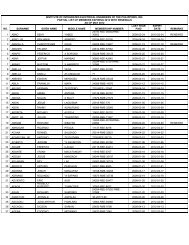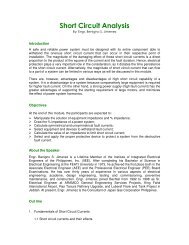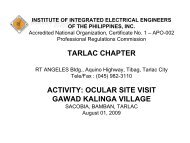The Electrical Engineer - Institute of Integrated Electrical Engineers ...
The Electrical Engineer - Institute of Integrated Electrical Engineers ...
The Electrical Engineer - Institute of Integrated Electrical Engineers ...
Create successful ePaper yourself
Turn your PDF publications into a flip-book with our unique Google optimized e-Paper software.
DISTRIBUTED GENERATION<br />
By Engr. Jules S. Alcantara<br />
IIEE VP Technical (2010), PEE, ASEAN <strong>Engineer</strong>, MS Energy Mngt, M. Engg (EE), CESO V<br />
Distributed Generation (DG) is generally defined as<br />
small scale electric power generation within distribution<br />
networks or on the customer side <strong>of</strong> the network. Other<br />
terms used are “embedded generation”, “dispersed<br />
generation”, “decentralized generation”, “Distributed<br />
Energy Resource (DER)” and “Distributed Resource<br />
(DR)”. <strong>The</strong> terms “cogeneration”, “RE” and “small power<br />
production” refer to types <strong>of</strong> DGs.<br />
<strong>The</strong> Philippine Renewable Energy Act <strong>of</strong> 2008 defines DG<br />
as up to 100 kW. <strong>The</strong> Electric Power Research <strong>Institute</strong><br />
(EPRI) defines the rating <strong>of</strong> DG to be up to 50 MW.<br />
<strong>The</strong> IEEE Standard 1547-2003 covers capacities up to<br />
10,000 KW.<br />
<strong>The</strong>re are three types <strong>of</strong> DGs: (a) solid-state or static<br />
invertors (b) induction machines (c) synchronous<br />
machines. <strong>The</strong> inverter type acts as current source while<br />
the rotating machines act as voltage source. <strong>The</strong> former<br />
type supplies lower fault current levels than the rotating<br />
machines.<br />
<strong>The</strong>re are currently 12 million DG units installed in the<br />
US with a total capacity <strong>of</strong> about 200,000 MW. Many<br />
<strong>of</strong> these units are used as back-up units to provide<br />
emergency power during shortages or unavailability <strong>of</strong><br />
power from the grid.<br />
<strong>The</strong> purposes and benefits <strong>of</strong> the DG include the following:<br />
1. DGs provide active power within the distribution<br />
network;<br />
2. It ensures continuity and availability <strong>of</strong> power<br />
for critical business processes;<br />
3. It may result in improvement <strong>of</strong> system reliability<br />
– A study on the Pennsylvania/New Jersey/<br />
Maryland interconnection (PJM) system by the<br />
Oak Bridge National Laboratory indicated that<br />
capacity expansion with ten small plants showed<br />
a better Loss <strong>of</strong> Load Probability than an<br />
expansion <strong>of</strong> a single large plant <strong>of</strong> the same<br />
size;<br />
4. DGs are highly efficient (overall efficiency<br />
greater than 75% ) and financially attractive<br />
when the DG industrial owner captures the heat<br />
generated from the DG technology for use in<br />
production processes, for hot water domestic<br />
use and other uses.<br />
5. DGs resolve power quality problems <strong>of</strong> voltage<br />
sags and disruptions;<br />
6. <strong>The</strong> use <strong>of</strong> alternative/renewable energy<br />
resources for DG enhances environmental<br />
conditions since it may have zero emissions. <strong>The</strong><br />
TECHNICAL PAPER<br />
Philippine Renewable Energy Act formally<br />
jumpstarts non-utility-owned small scale<br />
distributed generation technologies <strong>of</strong> the<br />
renewable type;<br />
7. New fuel powered and waste-to-energy DG<br />
technologies have low emissions that also<br />
enhances environmental conditions;<br />
8. New technologies in DG have made it possible<br />
to tailor energy systems to the specific needs <strong>of</strong><br />
the consumer;<br />
9. DGs may provide ancillary services including<br />
voltage support/reactive power and back-up;<br />
10. Peak power requirements are reduced;<br />
11. Reduces and <strong>of</strong>fsets investments in generation,<br />
transmission or distribution facilities that would<br />
otherwise be recovered through rates. <strong>The</strong>re are<br />
also savings in T & D losses and Congestion<br />
costs;<br />
12. Reduces vulnerability to terrorism and<br />
improvements in infrastructure resilience;<br />
13. Reduces land-use effects and Right-<strong>of</strong>-<br />
Way acquisitions to build new power plants,<br />
electric transmission and distribution lines;<br />
14. Short construction times compared to central<br />
generators;<br />
15. Inherent system stability due to multiplicity <strong>of</strong><br />
inputs;<br />
16. Weather related interruptions are more easily<br />
predicted and <strong>of</strong> shorter duration.<br />
<strong>The</strong> IEEE 1547-2003 Standard for Interconnecting<br />
Distributed Resources with Electric Power Systems is<br />
a standard developed by the <strong>Institute</strong> <strong>of</strong> <strong>Electrical</strong> and<br />
Electronics <strong>Engineer</strong>s (IEEE) meant to provide a set <strong>of</strong><br />
technical criteria and requirements in the interconnection<br />
<strong>of</strong> distributed generation resources into the power grid<br />
in the United States. It facilitates the tapping and use <strong>of</strong><br />
excess capacity <strong>of</strong> electricity from alternative sources.<br />
<strong>The</strong> US Congress in its US Energy Policy Act <strong>of</strong> 2005<br />
established the IEEE 1547 as the national standard for<br />
the DG interconnection. Other applicable standards are<br />
the UL and National <strong>Electrical</strong> Code <strong>of</strong> the NFPA (USA)<br />
while the Philippines has the existing Philippine <strong>Electrical</strong><br />
Code (IIEE), the Philippine Grid Code and the Philippine<br />
Distribution Code. However, technical standards for DG<br />
interconnection differ from country to country.<br />
Some <strong>of</strong> the technical issues to be addressed in the<br />
interconnection <strong>of</strong> DGs to the existing power system are<br />
the following:<br />
1. Voltages outside an acceptable range (IEEE<br />
1547-2003 mandates tripping in 0.16 sec for<br />
U1.2 pu);<br />
THE ELECTRICAL ENGINEER MAGAZINE 3RD QUARTER 2010 33













